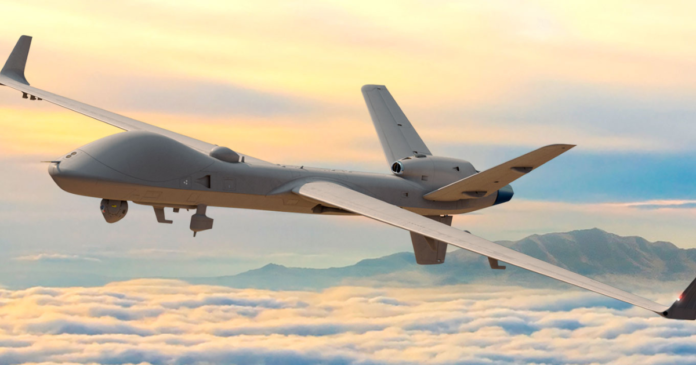MQ-9B Reaper: In a big boost for India-US defence ties, the United States has approved the sale of 31 MQ-9B remotely piloted aircraft (RPA) and associated equipment to India for an estimated $3.99 billion (Rs 33,060 crore).
“The State Department has made a determination approving a possible Foreign Military Sale to the Government of India of MQ-9B Remotely Piloted Aircraft and related equipment for an estimated cost of $3.99 billion. The Defence Security Cooperation Agency (DSCA) delivered the required certification notifying Congress of this possible sale today,” the DSCA said in a statement.
The purchase of the MQ-9B and MQ-9 Reaper drones is noteworthy since it was reportedly delayed due to rumors of an attempted assassination of Khalistan activist Gurpatwant Singh Pannun on US soil. According to media reports, officials shot down rumors that the Pannun investigation would determine whether or not the purchase would go through.
However, officials had claimed that the issue is insignificant and has little bearing on the significant bilateral relationship between the two countries.
How will India benefit from MQ-9B drones?
The first hunter-killer unmanned aerial vehicle (UAV) intended for long-endurance and high-altitude observation is the General Atomics Aeronautical Systems MQ-9B drone. The drones have a wingspan of more than 22 meters and measure 11 meters in length.
They claim to be able to work for more than 27 hours at altitudes of up to 50,000 feet. They also feature a 1,746 kg payload capacity, which includes 1,361 kg of external supplies, and a 240 Knots True Airspeed (KTAS).
Multiple mission payloads, such as laser designators, Lynx multi-mode radar, multi-mode maritime surveillance radar, electronic support measures (ESM), and other weapons and payload packages, can be carried by the drone.
A two-person crew, including a pilot and an aircrew member to operate the weapons and sensors, controls the UAV remotely.
The Reaper can use “eight laser-guided missiles, air-to-ground missile-114 Hellfire, which possess highly accurate, low-collateral damage, anti-armour and anti-personnel engagement capabilities,” according to the US Air Force.
According to The Guardian, the Predator, Reaper’s predecessor, gained notoriety for being employed in “precision strikes” that resulted in a large number of civilian deaths in the Iraq and Afghanistan conflicts. The USAF discontinued the RQ-1/MQ-1Predator in 2017, making Reaper the main unmanned aircraft in the force.
The Predator, Reaper’s predecessor, gained notoriety for being employed in “precision strikes” that claimed many civilian lives in the Iraq and Afghanistan conflicts. The USAF discontinued the RQ-1/MQ-1Predator in 2017, making Reaper the main unmanned aircraft in the force.
The MQ-9 Reapers can strengthen the intelligence, surveillance, and reconnaissance (ISR) capabilities of India’s armed forces with its long-endurance, persistent surveillance, and strike capability.
These drones are utilized primarily as an “intelligence-collection asset and secondarily against dynamic execution targets,” according to the US Air Force.
“Given its significant loiter time, wide-range sensors, multi-mode communications suite, and precision weapons, it provides a unique capability to perform strike, coordination, and reconnaissance against high-value, fleeting, and time-sensitive targets,” the USAF said in a statement.
Given that India and its neighbors, Pakistan and China, continue to have tense relations, this heightened reconnaissance by the MQ-9B Reaper will be helpful.
Features of MQ-9B drones
The first hunter-killer unmanned aerial vehicle (UAV) intended for long-endurance and high-altitude observation is the General Atomics Aeronautical Systems MQ-9B drone. The drones have a wingspan of more than 22 meters and measure 11 meters in length. They claim to be able to work for more than 27 hours at altitudes of up to 50,000 feet. They also feature a 1,746 kg payload capacity, which includes 1,361 kg of external supplies, and a 240 Knots True Airspeed (KTAS).
Multiple mission payloads, such as laser designators, Lynx multi-mode radar, multi-mode maritime surveillance radar, electronic support measures (ESM), and other weapons and payload packages, can be carried by the drone.
A two-person crew, consisting of the pilot and an aircrew member to operate the sensors, controls the UAV remotely.
The Reaper can use “eight laser-guided missiles, air-to-ground missile-114 Hellfire, which possess highly accurate, low-collateral damage, anti-armour and anti-personnel engagement capabilities,” according to the US Air Force.
Which nations use MQ-9B Reaper drones?
The US military, NASA, the Royal Air Force of the United Kingdom, the Italian Air Force, the French Air Force, and the Spanish Air Force are currently using Reaper drones. In April of last year, Japan also welcomed the MQ-9B Sea Guardian drones.
Between 2014 and 2018, the UK Air Force conducted at least 2,400 operations in Iraq and Syria using these drones.
Notably, in January 2020, a MQ-9 Reaper drone is thought to have carried out a US drone strike in Iraq that claimed the life of Iranian commander Qassem Soleimani.
In 2022, Ayman al-Zawahiri, the leader of Al-Qaeda, was eliminated in Kabul by means of an alternative drone known as the MQ-9A Reaper.



